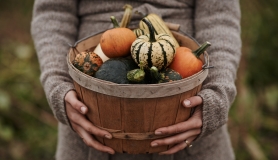As babies, we come into this world with a natural joy. A baby who’s been fed, changed, rested, often squeals with delight at life on receiving some loving attention. We were all that baby at one time. And an adult in an MRI machine who is free of physical or mental stress exhibits a brain that is conscious, calm, creative, caring, and content. We don’t have to look for well-being outside of ourselves. It’s right inside us waiting to be remembered, accessed, and awakened. And we can help our children get in touch with that joy by teaching them simple practices and encouraging them to live from that place more and more.
Every one of us wants to be happy. Even those who like being grumpy act that way because they think it makes them feel better! The wish for happiness comes from the most basic movement of heart that wants greater well-being. Everything we do or say is based on a motivation deep within to either bring relief or improve our internal state. Even the misguided actions that lead to more suffering come from an attempt to increase our feeling of well-being.
The problem is we often don’t realize which things lead to genuine happiness and which things lead to suffering.
“The wish for happiness comes from the most basic movement of heart that wants greater well-being”
The Three Principles of Awakening Joy
Everything we do is motivated by the wish to feel better or feel less bad. Most of us can relate to being caught in habits that don’t serve us or are even self-destructive. But we do them anyway because in the short term they make us feel good in some way. The Awakening Joy Three Principles are:
1. Understand where true happiness lies; 2. Take in the good; 3. Practice makes perfect.
THE FIRST PRINCIPLE
UNDERSTAND WHERE TRUE HAPPINESS LIES: The first important principle is understanding where true happiness lies and what conditions support it. Think of times when you’re feeling true well-being. I don’t mean the quick hit of pleasure when you’re eating a jam doughnut. I’m talking about things like dancing, snuggling with your pet, having fun with your kids, or being outside in nature on a gorgeous day.
When you examine true states of healthy well-being like these, they are accompanied by a feeling of expansiveness that can be experienced in the body as well as the mind. These are directly in contrast to states of distress such as anger, worry, fear, or sadness that are accompanied by contraction or agitation in the body as well as the mind. Even wanting something might seem like a positive experience but looking at it carefully, there’s a feeling of incompleteness that is really unpleasant. So what we’re doing in awakening joy is first identifying and then cultivating ten different expansive states that are fundamental to true well-being.
THE SECOND PRINCIPLE
TAKE IN THE GOOD: The second principle is a reminder to notice that these states of true well-being have a quality of uplift or gladness such as aliveness, openness, ease, relaxation, or lightness. The mind also feels invigorated and light as well. As good as these feel, we all too often miss the sweet delight of these pleasant moments. We might know we feel good but we don’t take the time to feel what feeling good actually feels like. Instead we’re lost in our head thinking about the past or planning the next thing to do. In fact, we’re wired up to look for danger and what can go wrong. As neuroscientist Dr. Rick Hanson says, our brains are like Teflon for positive experiences and Velcro for negative ones.
By taking a few moments to truly savour the feeling of well-being, our awareness is registering the experience in a very profound way. Awareness acts like both a spotlight and a vacuum for the brain. When we’re present for the uplifting experience, it’s both brought to the forefront of our consciousness and registering deeply in our brain’s neural pathways.
THE THIRD PRINCIPLE
PRACTICE MAKES PERFECT: As we practice letting our moments of well-being register, we begin a profound shift: instead of being stuck in the ruts of our mind, we start creating happiness grooves. This theory that repetition affects the likelihood of subsequent firing was first proposed by neuroscientist Donald Hebb in his book The Organization of Behavior published in 1949. Siegrid Lowel later put it into the famous neuroscience axiom: “Neurons that fire together, wire together.” Hanson suggests taking 10–15 seconds to really let it sink in when you’re experiencing a joyful moment and to try doing that six times in a day. (Can you handle 60–90 seconds of well-being in a day?) If you practice doing this over a two-week period, you will likely notice a significant increase in well-being.
This is because you are not only registering those feelings of well-being, but you’re also getting into the habit of looking for them. We begin to “prime the brain,” as Dr. Dan Siegel says, to be on the lookout for those moments. Another way of understanding this is what is referred to as the brain’s “confirmation bias.” That is, your brain will selectively notice what it’s looking for. Why not be on the lookout for joy?
THE TEN STEPS OF AWAKENING JOY
With these three underlying principles, the process of Awakening Joy includes cultivating ten different healthy states of well-being, being present when they arise so that over time the brain becomes more and more inclined toward happiness. Although each state can be cultivated on its own, there is a logic to the particular sequence as it’s presented that builds over time.
First, we start with intention to be happy, which means deciding to allow more happiness in our lives. This is Step One, the most important decision we can make. It sets in motion the whole process of inclining the mind and heart toward true well-being. Next, we learn the power of mindfulness, which is what I call the basic tool of a joyful life. As we become more present in our life we naturally develop the third state, a grateful heart.
Appreciating all the good in our lives helps us open to the inevitable difficulties that arise. Learning to be with our challenges in a skillful way is the Fourth Step in this process. The Fifth Step understands the power of integrity, not doing harm and knowing the joy of being aligned with our highest values. The Sixth Step naturally follows, the joy of letting go, learning to restrain ourselves from impulsive behaviour that we will later regret.
As we act with wisdom and kindness we can experience for ourselves the Seventh Step, learning to love ourselves. We know and do what is good for us because we feel deserving of true happiness. This supports us to experience the Eighth Step, enjoying a healthy connection with others. As our connection and caring increase we enjoy the Ninth Step, expressing our compassion when we see others around us having a hard time. Finally, the Tenth Step is the joy of simply being, where we learn to truly relax and embrace what’s happening right now even when it’s not exciting or fun. We can learn to find joy in the ordinary moments of life and know that they are worthy of our attention.
MORE INSPIRATION
READ Awakening Joy in Kids by James Baraz and Michele Lilyanna
EXPLORE awakeningjoy.info for downloads and courses
CREATE YOUR NOURISHMENT LIST
Instead of just leaving the arising of joy to chance, it’s helpful to remember what awakens it in you. To a large degree our experience of joy is supported by how much we actually nourish our spirits. Nourishing our spirits is usually connected with engaging in healthy activities and experiences. If we’re too busy to nourish our spirits, we’re too busy. Try this exercise to help you create your “Nourishment List,” adapted from How We Choose to Be Happy by Rick Foster and Greg Hicks:
- Take four minutes to write down everything that brings you joy. The list can include the simplest thing, like watching a sunset; or something exotic, like hang-gliding; or anything in between (walking your dog, listening to music, etc.).
- Check all the items you do regularly in your life.
- Now circle the things that are realistic to include in your life these days.
- At least twice a week, choose to engage in one of the items as a support for awakening joy. Remember to be present for the feeling of well-being whenever it arises.
Notice When You’re Happy
To deepen our happiness, a key practice is noticing a joyful state when it’s here. When we feel grateful or happy or calm or compassionate, it registers more deeply if we are present right in the middle of the experience. These moments are easy to miss unless we have our radar out for them.
Pay Attention to When You’re Feeling Good
Notice with interest how it feels in your body and mind so you can directly experience it. This is different from vaguely knowing, “I feel good.” Rather, you are exploring with curiosity the landscape of well-being by exploring what it’s like to feel good.
When you’re in the middle of an enjoyable moment, whether it’s walking, listening to music, or watching a sunset, don’t miss it! Be present for these uplifting joyful experiences.







